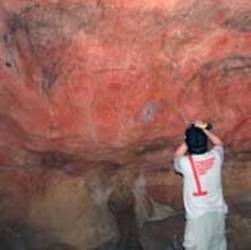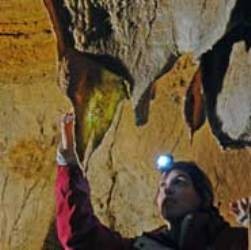El Castillo Cave Art Is Older Than Previously Estimated [PHOTOS]
Researchers have discovered that the oldest cave art at El Castillo in northern Spain is older than previously estimated.
Researchers from the University of Bristol have discovered that the El Castillo cave painting is more than 41,000 years old, making it Europe's oldest known cave art. They believe that the unique cave art was created either by the first anatomically modern humans in Europe or by Neanderthals.
"Evidence for modern humans in northern Spain dates back to 41,500 years ago, and before them were Neanderthals. Our results show that either modern humans arrived with painting already part of their cultural activity or it developed very shortly after, perhaps in response to competition with Neanderthals - or perhaps the art is Neanderthal art," said Dr Alistair Pike, researcher at the University of Bristol, in a statement.
Earlier, researchers believed that the cave art was 20,000 years old. Now, they have found that these paintings date back to 41,500 years ago. The discovery was made when they were studying fifty cave paintings in 11 caves in northern Spain, including the Unesco World Heritage sites of Altamira, El Castillo and Tito Bustillo.
During the study, the research team found tiny stalactites formation on top of the paintings, when they studied these stalactites using a technique known as uranium-series disequilibrium. They found that the paintings were quite older than previously estimated.
Usually, researchers and scientists use radiocarbon dating methods to know when exactly the paintings or art work were created, but Bristol researchers preferred the uranium-series disequilibrium method because they claim that radiocarbon dating does not work where there is no organic pigment.
"Engravings and, in many cases, paintings lack organic pigments or binders suitable for radiocarbon dating. So instead of using radiocarbon dating method, we measured uranium isotopes in the thin calcite flowstone growths that formed on the surfaces of the paintings and engravings to date the art. This technique, known as uranium-series disequilibrium, is used extensively in Earth Sciences and avoids the problems related to radiocarbon dating," said Pike
Researchers found that hand stencils and disks made by blowing paint onto the wall in El Castillo cave were found to date back to at least 40,800 years, making them the oldest known cave art in Europe, 5-10,000 years older than previous examples from France.
A large club-shaped symbol in the famous polychrome chamber at Altamira was found to be at least 35,600 years old, indicating that painting started there 10,000 years earlier than previously thought, and that the cave was revisited and painted a number of times over a period spanning more than 20,000 years.
"The key development was our method to date tiny calcium carbonate deposits similar to stalactites. We can now date samples of just 10 milligrams - about as small as a grain of rice. This has allowed us to find samples that had formed directly on top of hundreds of paintings, whereas the larger stalactites were much less frequent," said Dr Dirk Hoffmann, researcher at the National Centre for the Investigation of Human Evolution (CENIEH).
"Until now our understanding of the age of cave art was sketchy at best; now we have firmly extended the earliest age of European cave art back by several thousand years, to the time of the last Neanderthals and earliest Homo sapiens. These earliest images do not represent animals, and suggest that the earliest art was non-figurative, which may have significant implications for how art evolved," said Dr Paul Pettitt, cave art specialist at the University of Sheffield




© Copyright IBTimes 2025. All rights reserved.



















